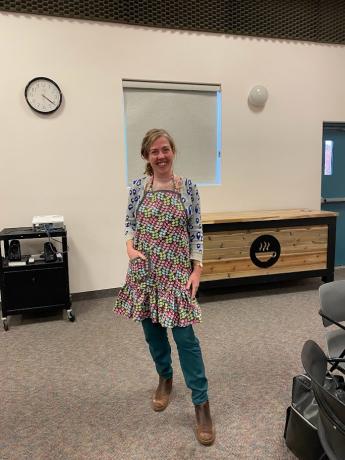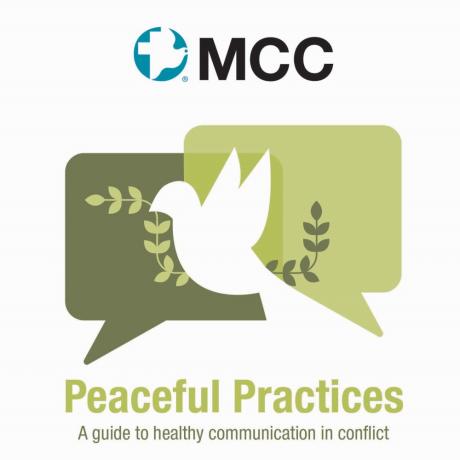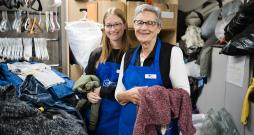January 2023: Peace is more than a wish, through improv

Tina and Anna (no relation to the author, despite sharing a name) are best friends. Every other Thursday, since Anna moved to Manitoba a few years ago, they gather to make comforters that MCC then sends to places experiencing acute disasters. The duo joins with other women who have sat together to sew for more than 30 years.
I recently travelled around Manitoba to talk to groups of comforter makers, including Anna and Tina. Part of my presentation involved the reminder that women gathering to sew has the power to change the world. I wasn't really expecting to learn something about peacebuilding to share with all of you as part of this project. After all, I was there to teach, not to learn.
After speaking, I sat down at Anna and Tina’s table for coffee and dainties. As she reflected on my presentation, Anna smiled when she told me that she also had a hard life. Yeah, Tina chimed in, if you knew everything that Anna has gone through, your heart would break.
"I had to choose to put down my bag of rocks," Anna tells us, referring to the grief and bitterness she held. Yet for most of the conversation, Anna tells us about joy; about how her life changed when she got her driver’s license at 16 and could drive herself to the chicken barn where she worked; about the friends and the happiness she now enjoys more than 60 years later, including the comforter group. She doesn't shy away from things that are difficult like Tina remarrying and moving out of her neighbourhood, but she doesn’t stop there either. Her life is more than one story. And because she can embrace all parts of that life, she experiences joy.
As I looked around the church basement, I began to wonder about the complexity present in all the lives in the room. It was easy to look at the group and assume one thing, just as I had when I arrived: this was charity work done by older women with some extra free time. When I dug a little deeper, the room filled: deep friendships, regular spaces of support, commitment to being together, creativity, faith, a care for community and others. Just like Anna, and just like all of us, their lives had been both hard and joyful. There were women who had lost loved ones to COVID and women who were new to Canada. The people in the room were there to, yes, engage in charity work. They were also there to share and live their lives with one another.

I’ve been paying attention to how often the phrase “yes but” shows up in my vocabulary, especially when I am in a situation where I want to be right or I face someone with a different opinion. It is easy to shut the conversation down with a well-placed “yes but.” To be honest, when we use “yes but” what we usually actually mean is no.
My comedy improv friends have been challenging me to replace “yes but” with “yes and.” In imrpov, “yes and” starts actively hearing what someone else is saying and incorporating that into your response. For example, in an improv scene, you accept the idea made by your conversation partner, which might be: “Let's go camping.” And you respond by saying, “Yes, and we can bring my new pet rock.” You listen and then respond in a way that moves the conversation forward.
When I use “yes and,” the way I engage shifts. Suddenly, I can pay attention to multiple possibilities. Yes, I am an expert on some things and I am also a learner. (See what I did there?) Women like Anna and the way she wholeheartedly approaches her life from a “yes and” perspective, along with the rest of the comforter makers, teach me to look for “yes and” in myself and in others and respond in kind.
What does this have to do with building peace? “Yes and” is a powerful practice for our peacebuilding toolbox. It acknowledges that it is possible to hold many identities and ways of being all at the same time. Jesus himself was both man and God. Jesus' disciples were powerful leaders and sometimes lost their tempers. When I am able to see myself and others as holding multiple identities, it is harder for me to view a situation or a person in simply one way. I can see spaces of agreement and common ground and, therefore, ways out of a conflict or a solution to a problem that I would not have seen before. Using “yes and” allows me to see the beauty in women like Anna and Tina and the work they are doing. When I can see that work as charity and peacebuilding work, suddenly, I can learn something new. A whole world of possibilities unfolds.
This is a new year. It’s the perfect time to start noticing and practicing moments of “yes and.” In this new month, can you look for spaces of “yes and” in yourself and in others? Pay attention to the phrase “yes but” and work to replace it with “yes and” and see what happens!
Reflection questions:
When you listen to the news or engage in social media, what phrase do you hear people using?
Pay attention as you speak and write. How often do you hear yourself using the phrase “yes but”? Practice replacing “yes but” with “yes and.” Does this shift how you engage with others?
What happens when you apply a “yes and” perspective to a political figure or family member you don’t agree with?
Action item:
Find a friend or two and, together, agree to challenge each other every time someone notices a group member using the phrase “yes but.” Work together to figure out how to apply a “yes and” lens to the situation and pay attention to what changes. If you are feeling especially creative, turn this into a game and work on developing your improv skills as a group. You can be a peacemaker and hilarious at the same time!
Ordinary People of the Month
Meet some ordinary people just like you working for peace in their communities. The feature for this month is, of course, comforter makers!
Volunteer Laura Nafziger (left) and Krista (last name withheld) work together on a comforter for MCC at Grand Valley Institution for Women in Kitchener, Ontario. This MCC project gave incarcerated women the opportunity to learn employable skills. “I’m here [in prison] because I took a life,” said Krista. “I joined the program so that I can give something back to the world and to be at peace with myself.”
Featured Resource

Want to dive deeper into peace skills with your community? Download MCC’s adult Sunday school curriculum, Peaceful Practices: A guide to healthy communication in conflict. It invites churchgoers to follow Jesus’ call to peacemaking through dialogue with each other.
This blog originally appeared on the Peace is More Than a Wish page.
Top photo: Nadine Ens and her daughter Jenice Ens tie knots in a comforter at The Great Winter Warm-up in Saskatoon, Saskatchewan. MCC photo/Myriam Ullah

